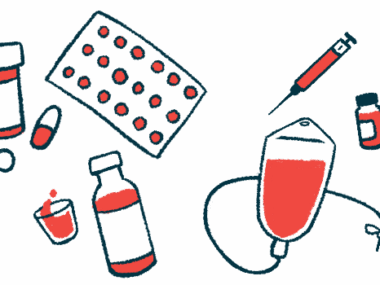Takhzyro Found Safe, Effective for HAE Over Long Term in Real-world Study
Written by |

About one year of treatment with Takhzyro (lanadelumab) safely and effectively lowered the frequency of swelling attacks, while improving quality of life and treatment satisfaction in people with hereditary angioedema (HAE), according to interim data from the real-world EMPOWER study.
In addition, nearly 1 in 5 patients was able to extend the time between Takhzyro doses from two weeks to four weeks.
Findings from the Phase 4 trial (NCT03845400), along with additional results from the Phase 3 HELP trial (NCT02586805) and its open-label extension study (NCT02741596), were shared through four posters at the 2022 American Academy of Allergy, Asthma and Immunology annual meeting, held Feb. 25–28 in Phoenix and virtually.
“We are pleased to see the real-world data from EMPOWER show improvements in angioedema control and treatment satisfaction,” Neil Inhaber, MD, head of rare genetics and hematology, global medical affairs at Takeda, which markets the therapy, said in a press release. “These interim results provide a better understanding of the overall patient experience with Takhzyro.”
Takhzyro is an approved treatment for the prevention of swelling attacks in people ages 12 and older with HAE types 1 or 2 in several countries, including the U.S., Canada, the European Union, China, Brazil, Switzerland, and Australia.
It works by suppressing the activity of kallikrein, a precursor of bradykinin — an inflammatory molecule overly produced in people with HAE, causing swelling and pain. As such, the therapy, administered as a subcutaneous (under-the-skin) injection, is expected to lower bradykinin levels and reduce the likelihood of HAE attacks.
Takhzyro’s recommended starting dose is 300 mg every two weeks, but dosing every four weeks may be considered, particularly for patients who remain attack-free for more than six months and have low body weight.
Regulatory approvals were mainly based on data from the Phase 3 HELP trial showing that Takhzyro, when given in its recommended regimen for six months, led to an 87% mean reduction in attack rates, compared with a placebo.
Patients treated with this regimen were also seven times more likely to show clinically relevant improvements in quality of life than those on a placebo.
Further results from HELP’s open-label extension study supported Takhzyro as a safe and effective treatment for up to 2.5 years.
EMPOWER is an observational, real-world study evaluating Takhzyro’s three-year safety and effectiveness in 165 type 1 or 2 HAE patients. Participants were recruited at sites in the U.S. and Canada. Data is being collected from patients via a smartphone app every three months and routine clinic visits every six months.
Three of the four posters presented at the meeting concerned interim data from the 93 patients enrolled in EMPOWER as of June 2021. Their mean age was 40.5 years, and a total of 78 participants had received at least four doses of Takhzyro before entering the trial (established users), while 15 had received fewer than four doses (new users).
Prior to enrollment, simultaneous health conditions were reported by 53.3% of new and 87.2% of established users and severe HAE attacks were reported by 20% of new and 5.2% of established users.
The poster, “Long-term effectiveness and safety of lanadelumab in the US and Canada: Findings from the EMPOWER Study,” showed that about 15 months of treatment with Takhzyro resulted in an 83% drop in attack rates among new users relative to the pre-treatment period.
Specifically, mean attack frequency was reduced from 1.2 monthly attacks to 0.2, or fewer than one attack per month — the same mean attack rate that was sustained throughout the treatment period in established users.
In addition, no new safety concerns were identified supporting the therapy’s safety profile reported in previous trials.
These results highlighted that Takhzyro was associated with a marked reduction in the frequency of HAE attacks among new users and a maintenance of low attack rates among established users.
Similar trends were observed after one year of treatment in patient-reported outcomes collected through the smartphone app, including the Angioedema Control Test, the Angioedema Quality of Life Questionnaire, and the Treatment Satisfaction Questionnaire for Medication.
New users showed improvements in disease control, quality of life, and treatment satisfaction, while these measures remained stable in patients already on Takhzyro before study entry.
These findings were presented in the poster, “Impact of lanadelumab on patient-reported outcomes in hereditary angioedema in the US and Canada: Interim findings from the EMPOWER Study.”
In addition, 16.9% of established users, or nearly 1 in 5, were able to switch from an every-other-week regimen to a monthly regimen, according to data shared in the poster, “Treatment patterns among patients with HAE-C1-INH: Interim analysis findings from US and Canada participants in the EMPOWER study.”
EMPOWER is expected to conclude at the end of 2023 and full results are anticipated in 2024.
In the poster, “Lanadelumab efficacy and safety after switching from androgens: analysis of the phase 3 HELP and HELP OLE studies for hereditary angioedema,” researchers presented the results of a post-hoc analysis of data from HELP and its extension study.
A post-hoc analysis is a type of analysis normally focused on a particular subject of interest that is performed after a trial has been completed.
This analysis focused on participants who were previously treated with androgen-based medications. Some lab-made androgens (male hormones) are used for the long-term prevention of HAE attacks, including Danocrine (danazol), Winstrol (stanozolol), and Oxandrin (oxandrolone).
In HELP, three patients received androgens before entering the trial, and the two participants who were assigned to Takhzyro showed a pronouncedly lower rate of HAE attacks after treatment than the one given a placebo.
HELP’s extension study included not only HELP participants, but also additional patients who had not participated in the trial. Among the latter, nine switched from androgens to Takhzyro’s recommended regimen and showed a 92% mean reduction in attack rates.
These findings highlighted that patients previously on androgen-based treatments showed similar responses to Takhzyro as the wider patient population in these trials.
“A big challenge for HAE patients is the unpredictability of attacks and the impact that the attacks have on quality of life,” said Paula Busse, MD, an associate professor in the division of allergy and clinical immunology at Mount Sinai’s Icahn School of Medicine in New York. “We are encouraged by the initial results of the EMPOWER study, along with the additional evidence presented in the HELP Open Label Extension.”






